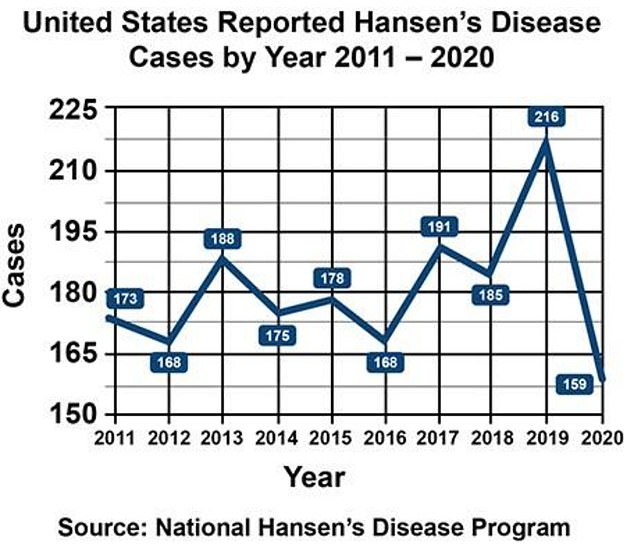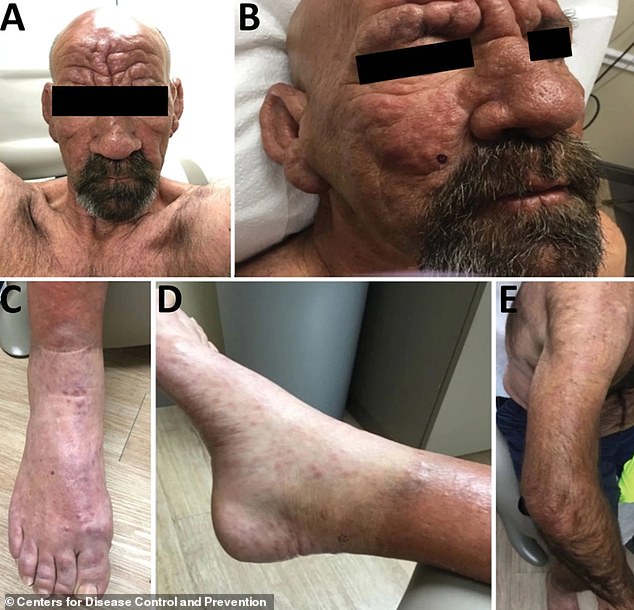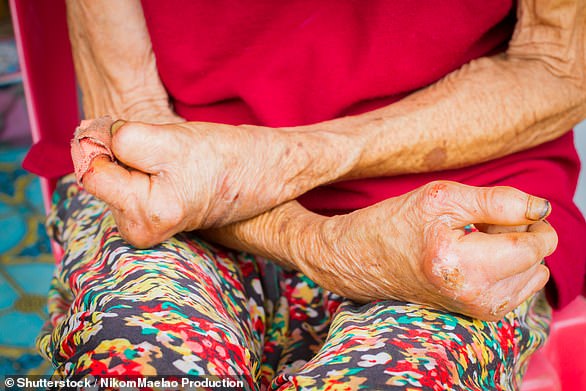Warning as Florida becomes a hot spot for leprosy in the US – and an unusual animal could be to blame
Leprosy, a rare flesh-devouring infection, has made a shocking comeback in Florida, where one county reported 13 percent of all cases in the entire United States.
Experts on the disease, now known as Hansen’s disease, have focused on locally infected armadillos as a known vector spreading the bacteria – which can cause nerve damage and deformity in humans if left untreated.
Armadillos in the Western Hemisphere have become natural carriers of the bacteria that causes leprosy since the disease was first introduced by European settlers centuries ago.
In the US, leprosy cases dropped to just 77 infections in 2000 thanks to a national campaign, but hundreds of new cases are now emerging in Florida, with Brevard County east of Orlando at the epicenter of the outbreak.
Medical experts investigating Florida’s leprosy outbreaks believe ‘something new is going on’ – and note that as-yet-unknown factors are helping the disease spread – but they are warning residents to avoid contact with known armadillos (pictured) is that they harbor the disease
A team of medical experts investigating these cases believe “something new is going on” – noting that as yet unknown factors are helping spread the disease – but they are still warning residents to avoid contact with armadillos.
“Floridians should be warned to keep their hands off armadillos,” wrote columnist Frank Cerabino for the Palm Beach Post this week, adding, “Don’t eat the armadillos.”
“We kill a lot of armadillos in Florida,” Cerabino told his readers.
“When threatened, such as by the roar of an approaching car, armadillos leap five feet into the air,” he noted, “right into the grille of the vehicle.”
“And it’s not hard to find YouTube videos online that show the steps for making armadillo chili,” Cerabino said.

Above, a nine-banded armadillo rescued by the Second Chances Wildlife Center in western Kentucky, many miles from Florida
Leprosy, often referred to in the Bible, has long been thought to have been eliminated because effective treatments have long been available.
Contrary to popular belief, leprosy does not cause a patient’s arms and legs to fall, or other serious necrotizing problems to occur.
Although the disease mainly affects the skin, it can cause hands and fingers to shrink.
A group of ten scientists worked together in 2023 to investigate the causes behind Florida’s troubled 21st-century history with this age-old scourge and now believe that contact with infected armadillos can explain only a fraction of the state’s new cases.
‘Some people who are infected have little to no exposure to the armadillo’ Doctor Norman Beattysaid an assistant professor of medicine at the University of Florida Tampa Bay Times.
“There is likely another source of transmission in the area,” Dr Beatty said.
Dr. Beatty, his colleague at the University of Florida, veterinarian Dr. Juan Campos Krauerand researchers from both Colorado State University and Emory University in Atlanta, Georgia, have come to suspect that insects, such as ticks, could play a role.
Early laboratory data have suggested that the blood-sucking parasites may spread infected blood that harbors the bacteria that cause leprosy. Mycobacterium leprae.
Another current theory blames amoebae, single-celled organisms that can live in soil and harbor the disease.
In fact, armadillos enjoy foraging for earthworms in yards and gardens, which the researchers suspected could cause these hard-shelled animals to shed leprosy bacteria as they search for literal food to eat.
A major reason for these new theories was that another traditional explanation has also proven unlikely: leprosy contracted while traveling abroad.

The graph above shows the number of leprosy cases in the US per year over the past ten years. The number of cases has been on an upward trend since a national low of just 77 cases in the year 2000
In the first decade of the 21st century, Florida’s increase in cases largely corresponded to people spending time abroad, according to Florida Department of Health data analyzed by the Tampa Bay Times.
But as local cases increased from 67 cases to 176 cases in the state between 2010 and 2020, Brevard County emerged as an unexpected hotspot.
Brevard reported 85 of those 176 cases that decade, after reporting just five cases the decade before — and at least 25 percent were people who had not left the state.
The small county, home to just 630,700 people, recorded nearly half of all infections in Florida at the time.
Leprosy strikes in record numbers in India, Brazil and Indonesia, which reported more than 135,000 infections in 2022 alone, but too many of the infected locals in Brevard came in with cases but had not traveled to those or other countries.
They had not even had close contact with registered local leprosy patients.
“Nothing made sense,” as epidemiologist Barry Inman, a former Brevard health department official, said.

A 54-year-old man in central Florida (above) was diagnosed with lepromatous leprosy in 2022. He sought treatment at a dermatology clinic for a painful and progressive rash
While other states are contributing to America’s rising number of leprosy cases, including California, Louisiana, Hawaii, New York and Texas, Florida appears to be the most concerning to federal regulators.
The CDC has recommended that travel to Florida should be considered when tracing leprosy contacts in any state.
Leprosy is also a reportable disease in Florida, where the disease is mainly controlled through passive surveillance.
According to the Florida Department of Health, health care workers are required to report leprosy in the state by the next business day, and this contact tracing is critical to identifying sources and reducing transmission.
Fortunately, about 95 percent of people have natural immunity against the bacteria that causes leprosy, according to the U.S. Centers for Disease Control and Prevention (CDC).
The first signs of the disease in humans include ulcers, muscle weakness and eye problems.
But if left untreated, leprosy can later cause growths and painful claw-like hands.
Unlike depictions of leper colonies from the Bible, current forms of the disease are not highly contagious if caught early, according to the CDC.

